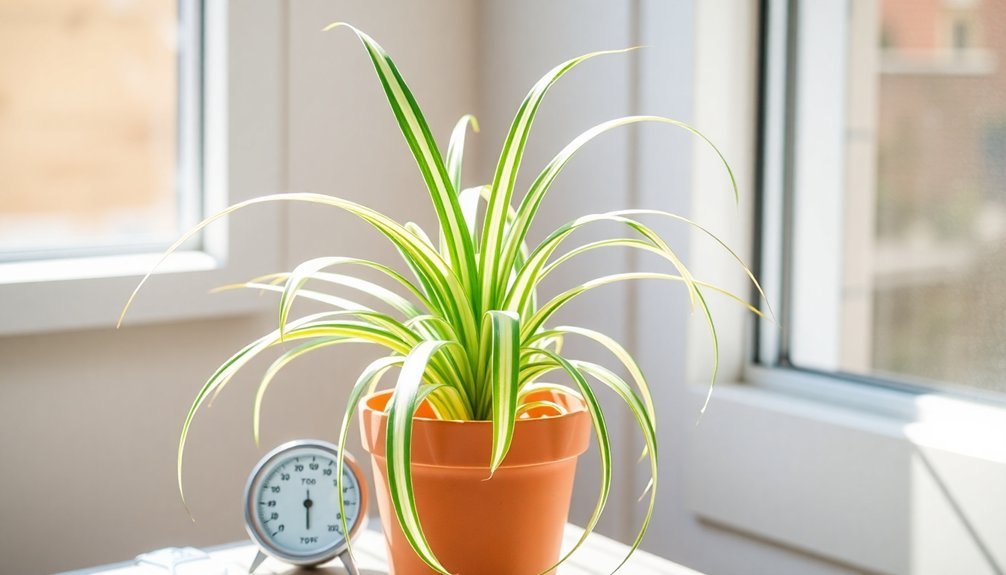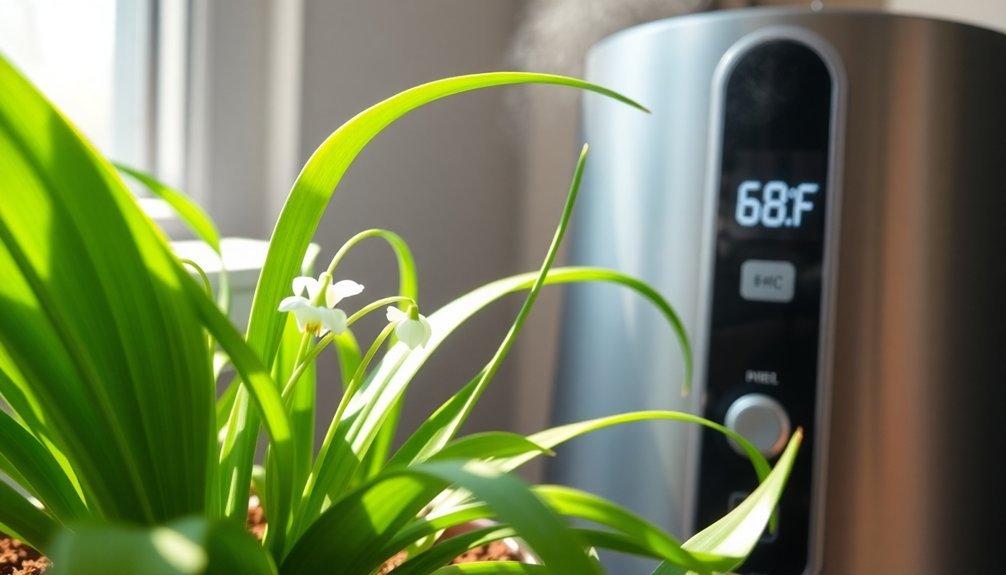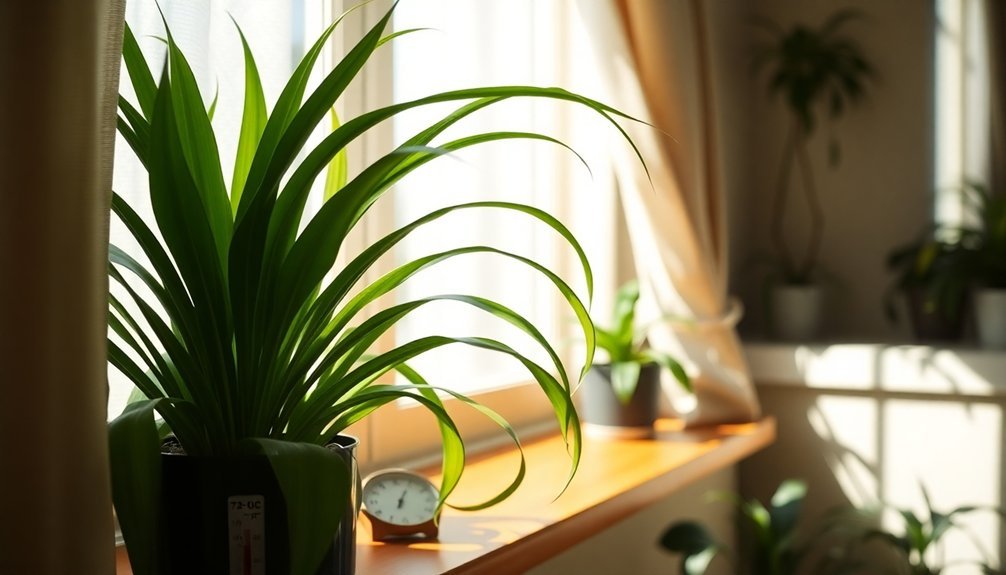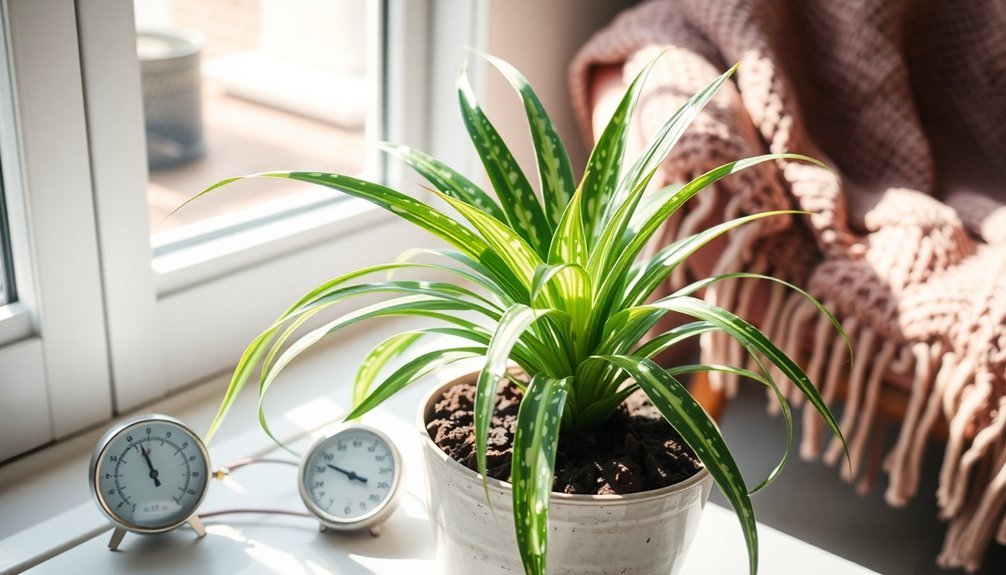Spider plants thrive best when you maintain temperatures between 60-75°F, their ideal comfort zone. Keep your plant away from drafty windows, heating vents, and AC units to prevent stress and leaf damage. You'll know your plant is happy when it produces healthy foliage and plenty of spiderettes. If you notice brown tips or mushy leaves, adjust your plant's location for more stable temperatures. Understanding these temperature sweet spots will reveal your spider plant's full potential.
Understanding Spider Plant Temperature Requirements

Although spider plants are known for their adaptability, maintaining the right temperature is essential for their growth and well-being. Your spider plant will thrive in a temperature range between 65°F and 90°F, with ideal growth occurring between 60°F and 75°F.
To guarantee your plant's success, you'll need to maintain stable temperatures and protect it from sudden changes. Keep your spider plant away from drafty windows, heating vents, and air conditioning units that could disrupt its environment.
Protect your spider plant from temperature shock by choosing spots away from drafts, vents, and air conditioners.
Temperatures below 50°F can prevent flowering and damage your plant, while exposure to heat above 90°F may cause leaf burn.
For the healthiest foliage and abundant spiderettes, maintain indoor temperatures between 65°F and 85°F. This consistent environment will help your plant flourish year-round.
Signs Your Spider Plant Is Too Cold
When your spider plant experiences cold stress, it displays several telltale signs that shouldn't be ignored. If you've placed your plant near drafty windows or in rooms below 55°F, you'll likely notice these warning signals that indicate your plant is too cold.
- Mushy, wilting leaves that feel soft to the touch
- Brown tips appearing on the leaf edges
- Stunted or completely halted growth patterns
- Discoloration across the foliage
To protect your spider plant, maintain a stable temperature between 65°F and 85°F.
If you spot these symptoms, immediately move your plant away from cold drafts and chilly windows.
Remember that prolonged exposure to low temperatures can prevent flowering and cause permanent damage. Your spider plant won't recover quickly from severe cold stress, so it's essential to address temperature issues promptly.
Preventing Heat Stress in Spider Plants

Just as cold temperatures can harm your spider plant, excessive heat poses its own set of challenges. To keep your plant thriving, you'll need to maintain temperatures between 65°F and 85°F.
Watch for signs of heat stress in your spider plant, including mushy leaves and brown tips. If you notice these symptoms, take immediate action to protect your plant. Keep it away from direct afternoon sunlight, which can rapidly increase leaf temperature beyond the safe range.
When temperatures climb above 90°F, your plant's growth may slow down, and leaves can suffer burn damage. You can prevent heat stress by using a humidifier and regularly checking indoor temperatures.
If needed, relocate your spider plant to a cooler spot in your home where temperature fluctuations are less extreme.
Seasonal Temperature Adjustments
Since your spider plant's temperature needs change throughout the year, you'll need to make strategic adjustments to maintain its comfort zone of 65°F to 85°F.
Making gradual seasonal adjustments helps prevent stress from temperature fluctuations while ensuring your plant thrives in every season.
Follow these key guidelines for year-round temperature management:
- Spring/Summer: Shield your plant from harsh afternoon sun and monitor AC settings to prevent cold drafts.
- Fall/Winter: Keep plants away from chilly windows and heating vents.
- Year-round: Check humidity levels regularly and use a humidifier when needed.
- Location Changes: Shift your plant gradually when moving it to prevent temperature shock.
Remember that consistency is essential – sudden temperature changes can stress your spider plant, so maintain stable conditions throughout the seasons.
Creating Temperature-Stable Growing Zones

To maintain your spider plant's health, establishing temperature-stable growing zones in your home creates the perfect environment for consistent growth.
Creating stable temperature zones in your home is essential for spider plants to thrive and maintain healthy, continuous growth patterns.
You'll want to identify areas that stay between 65°F and 85°F throughout the day, away from temperature fluctuations that can stress your indoor plants.
Choose spots that are protected from drafty windows, doors, and HVAC vents. During winter, move your spider plants away from cold windowsills and consider using a humidifier to maintain proper moisture levels while keeping temperatures above 50°F.
If you need to relocate your plant, do it gradually to prevent shock.
Monitor your chosen growing zones regularly with a thermometer, and watch for signs of temperature stress like leaf burn or slowed growth.
This attention to environmental stability will reward you with thriving, healthy spider plants.
Managing Indoor Temperature Fluctuations
Keep track of your home's daily temperature patterns to maintain the ideal 65-85°F range your spider plants need to thrive.
You'll want to adjust your thermostat settings throughout the year, considering both seasonal changes and daily fluctuations that could stress your plants.
To protect your spider plants from temperature swings, you should move them away from drafty windows, doors, and air vents where cold air might damage their sensitive foliage.
Monitor Daily Temperature Changes
While spider plants are generally adaptable houseplants, maintaining stable temperatures is essential for their well-being.
To monitor temperature changes effectively, you'll want to keep a thermometer nearby and check it regularly throughout the day. This simple practice helps guarantee your spider plant stays within its ideal range of 65°F to 85°F.
- Place your thermometer close to the plant for the most accurate readings
- Check temperatures during different times of day, including morning and evening
- Move your plant if you notice readings below 55°F or above 90°F
- Watch for drafts from windows, doors, or HVAC vents
Adjust Thermostat Year-Round
Since spider plants respond best to consistent temperatures, managing your home's thermostat throughout the year plays an essential role in their care.
Keep your indoor temperature between 65°F and 85°F to guarantee ideal growth conditions for your plants.
During summer months, you'll need to protect your spider plants from temperature fluctuations caused by air conditioning units.
Place them away from vents and avoid direct sunlight, which can create hot spots and stress your plants.
In winter, maintain steady warmth by positioning plants away from drafty windows and heating ducts.
Set your thermostat to maintain consistent temperatures day and night.
If you're using a programmable thermostat, don't let nighttime temperatures drop below 65°F.
Consider using a humidifier during heating season to offset dry air and support your spider plant's overall health.
Prevent Cold Draft Exposure
Protecting your spider plant from cold drafts requires strategic placement within your home to maintain their preferred temperature range of 65°F to 75°F.
To create a stable environment and prevent temperature fluctuations, monitor your indoor climate and take proactive measures against cold draft exposure.
Key actions to protect your spider plants:
- Move plants at least 3 feet away from exterior doors, windows, and air conditioning vents
- Install draft stoppers under doors and weatherstripping around windows where cold air might leak
- Use insulating curtains during colder months to maintain consistent temperatures
- Check for drafts by holding your hand near potential cold spots – if you feel air movement, relocate your plant
Remember that sudden temperature drops below 50°F can stress your spider plant, so maintaining consistent warmth is essential for its health and growth.
Temperature's Impact on Spider Plant Growth
Spider plants rely on three key temperature zones that directly influence their growth and health. You'll find ideal growth when keeping your plant between 65°F and 85°F, while temperatures outside this range can cause stress and damage.
Temperature Zone | Impact on Plant
—————–|—————-
Below 55°F | Stunts flowering, causes growth setbacks
55°F – 65°F | Slows growth, but manageable
65°F – 85°F | Ideal growth zone, healthy foliage
85°F – 90°F | Mild stress, watch for signs
Above 90°F | Heat stress, leaf burn occurs
Watch for warning signs that your temperature isn't right. Brown leaf tips often indicate temperature fluctuations, while mushy leaves suggest exposure to cold drafts. For best results, maintain your home's temperature between 60°F and 80°F, creating a stable environment that promotes vibrant growth and prevents temperature-related stress.
Balancing Temperature With Humidity Needs

Maintaining the right temperature alone won't guarantee your spider plant's success – humidity plays an equally important role. Your plant thrives when temperature and humidity work together, ideally keeping temperatures between 60-80°F and humidity levels at 40-60%.
Spider plants need a perfect balance of warmth and moisture – aim for 60-80°F with 40-60% humidity for optimal growth.
To create the perfect environment for your spider plant, follow these key practices:
- Monitor humidity levels regularly to prevent brown tips from forming on leaves
- Use a humidifier during dry seasons or in air-conditioned spaces
- Mist your plant occasionally if you notice signs of low humidity
- Keep your plant away from heating vents and cold drafts that can create temperature fluctuations
Emergency Temperature Protection Strategies
When unexpected temperature changes threaten your spider plant's well-being, you'll need to act quickly with emergency protection measures. Watch for signs of temperature stress like brown leaf tips and act swiftly to protect your plants from cold drafts and extreme indoor temperatures.
| Emergency Action | Quick Solution |
|---|---|
| Draft Protection | Move away from windows and doors |
| Temperature Check | Use thermometer to monitor 60-80°F range |
| Heating Support | Deploy space heater or heat mat |
| Location Change | Relocate to insulated area |
| Group Strategy | Cluster with other plants |
Create a defensive plan before temperature emergencies strike. If you notice your spider plant struggling, don't wait – implement these protective measures immediately. Remember, maintaining consistent temperatures is easier than recovering from cold damage, so monitor your plant's environment regularly and adjust as needed.
Frequently Asked Questions
What's the Lowest Temperature a Spider Plant Can Handle?
Your spider plant can survive down to 50°F (10°C), but you'll want to keep it above 55°F (12°C) to prevent growth issues and leaf damage. Cold exposure below 50°F will stress your plant.
How Do I Keep My Spider Plant Happy?
Keep your spider plant in bright indirect light, maintain temperatures between 65-85°F, and guarantee good humidity. Don't let it get too cold, avoid drafts, and mist regularly to prevent brown tips.
Where Is the Best Place to Put a Spider Plant?
Place your spider plant near a north-facing window where it'll receive bright, indirect light. You can also put it on a shelf or hanging basket away from drafts and heating vents for ideal growth.
Will Sugar Help a Spider Plant?
No, don't add sugar to your spider plant. It'll actually harm your plant by promoting fungal growth and root rot. Instead, you'll get better results using regular fertilizer and maintaining proper soil conditions.
In Summary
Keep your spider plant thriving by maintaining temperatures between 60-75°F. You'll see the best growth and health when you're consistent with this sweet spot range. If you're noticing temperature fluctuations, act quickly with humidity adjustments and strategic placement. Don't forget to monitor seasonal changes and protect your plant from drafts and heat sources. With proper temperature control, you're setting your spider plant up for long-term success.





Leave a Reply